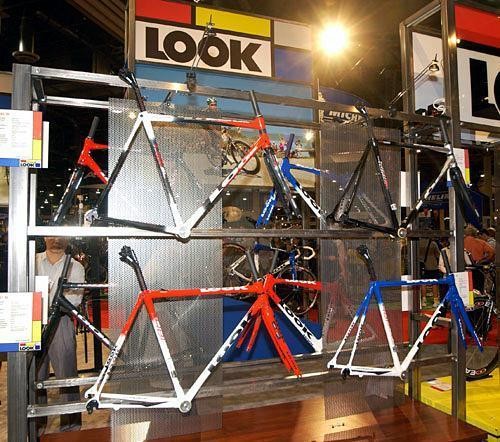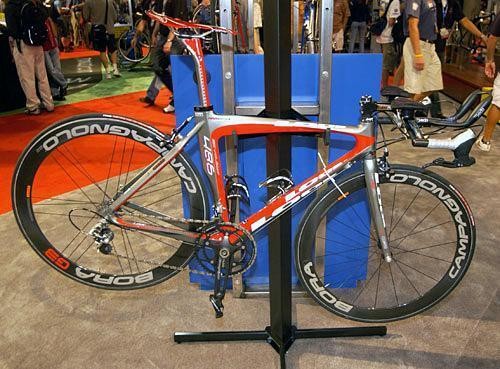It's not all about weight in the real world
Following on from last week's discussion on the relevance of the UCI's 6.8kg complete bike weight...



Tech feature - November 23, 2004
Following on from last week's discussion on the relevance of the UCI's 6.8kg complete bike weight limit, Cyclingnews speaks to Dominique Bergin, president, director general and chairman of Look Cycling International, who attended the Interbike exhibition in Las Vegas last month.
The bike industry is in the middle of one of its periodic frenzies of obsession with weight, though this time round things aren't - yet - as silly as the the 'make it lighter till it fails' mountain bike parts of the early nineties and the 'drill holes in it till you can use it to grate cheese' road components of the seventies. So when Cyclingnews gets chatting with Dominique Bergin, president of legendary French frame and pedal manufacturer Look, it's not surprising that weight is one of the first topics that crops up.
"If you have to make a light frame that helps the bicycle fall under the UCI's weight limit - you can!" says Bergin. "It's easy, but it's also too rigid."
Bergin says the end result can be a bicycle that is so stiff and uncompromising that it "gives nothing back to the rider". He says the aim at Look is to build a frame that is light, but also one that the rider can live with.
In marketing-speak, Look calls this its 'Dual Comfort & Stiffness Concept'. Bergin says that for a frame to be efficient, it has to be both stiff and flexible, providing a good response but also a level of comfort. While it may seem these aims are mutually exclusive, Look claims it's all in the way the composite components are produced, with different shapes and fibre orientation in the tubes, while the lugs made under different pressures.
For 2005, Look has released the new 585 frameset, a lugged composite frame in the slightly compact-geometry style, that weighs in at 990 grams, under the 1kg benchmark and used this year by Credit Agricole's Christophe Moreau in the Tour de France. It's also released the new KeO pedal (see separate story) that is only 230 grams per pair - and that's with plain old steel axles.
The latest race content, interviews, features, reviews and expert buying guides, direct to your inbox!
"But reducing the weight was not really the aim, but a consequence of our work in research and development. We also have Laurent Jalabert as our consultant and he has so much experience on the road. It's very useful to have technology that allows you to build under the [UCI's weight] limit, so then you can have more grams to provide a frame that gives you more energy back and more comfort," he said.
As for the UCI's weight limit, Bergin is reasonably comfortable with the current rule. "We consider a rule at the time and then there is evolution and sometimes the rule can be absolute; 'this is the rule'. It is like the speed limit, you can have very fast, very powerful cars, like Porsche, Ferrari, but the speed limit is for all cars. So in a competition, you have to accept the rules.
"The market is maybe too focused on the weight and at Look, we have very light new products, the new KeO pedal, a new frame that is less than one kilogram, a new fork which is the only complete fork in carbon that is 295 grams," he says.
The company can certainly lay claim to being one of the innovators of using composite materials in bicycles. But at the same time, Bergin says Look's aim is to offer frames that retain the "real qualities" of a good bicycle, such as being a reliable mount for day-to-day riding and racing.
It has to be said that many of Look's frames come in at the slightly porky end of composite frames, but for good reason. Look's high profile consultant, French cycling legend Jalabert, provides the experience on the saddle that influences design.
One of Jalabert's signature models is the new 481SL, the model that succeeds the venerable 381i (Jalabert's frame for much of his career, winner of Bike of the Year in France, and so on). This bicycle looks like it could still be made from metal tubes, such is the traditional look of the relatively thin carbon construction and relaxed 'ride-all-day' geometry. The bicycle is designed for road racing, but weighs 1350 grams. At the same time, it could also be argued that this weight 'penalty' may be of little consequence to the rider who wants a bike for the long hauls on badly-surfaced roads.
It indicates another aspect of Look's design philosophy - put simply and with no pretension to elegant French phrases - it's about horses for courses. If you consult the geometry charts of many frame-builders - it's the same set of angles regardless of materials, price or intended function. However, quality frame-builders tend to alter the angles and dimensions somewhat to produce bikes that are designed for a specific purpose; a criterium racing frame will feature a higher bottom bracket and tight angles, whereas the genuine road racing steed will sit lower and have more relaxed angles and predictable (if slower) steering.
Look goes further and also has four different types of tube construction, as well as what it calls 'Monobloc' (single-piece) construction. Each set of tubes are said to provide different ride qualities at varying weights and price points.
But as materials science develops, weight remains the prevailing criteria, at least in the marketing side of the business.
'Forged carbon'
A key feature of the new sub-1kg 585 frameset is the use of a new composite molding process called 'Carbone Forge'. This is where a range of pressures are used in the manufacture of various components, resulting in varying levels of material density, which in turn affects weight and rigidity.
"We worked very hard in the design of the lugs and the bottom bracket," Bergin said of the 585. "The bottom bracket shell is made from a single piece of carbon, what we call 'forged carbon'. It is compressed in a mold, under a very high pressure."
According to Look, a pressure of 250 bar (atmospheres) is applied when 'baking' the bottom bracket shell of the 585. Compare this to the 10-15 bar that is applied when molding the tubes. The 'forged carbon' process ('Carbone Forge' is Look's newly registered trademark) is said to result in a BB shell that rivals aluminium in stiffness, but is 50 percent lighter.
Other parts of the 585, such as the seat and head tube, are made using 20 bar pressure, as these components do not need the same qualities as the BB shell. Bergin said the Carbone Forge technology is unique to Look and helps to keep its lead in the composite frame business.
Not so long ago, composite bikes out of Europe came mainly came from this French manufacturer, but now almost every bicycle maker in the world has composite bikes on offer. Many are virtual 'generics', made in factories in Taiwan and China and where the main difference is in the paintwork.
The contemporary 'generic' composite bicycle has the potential to turn the industry into a pure marketing business, not unlike PC industry, where the casing basically houses the same components, differing only by badge and branding. Some would argue that's happened already.
So how does the spread of composite technology affect a company that had made its name by being somewhat unique in this area? Bergin said there's more to composite frames than what's produced by an anonymous factory in Asia.
"There are some good competitors, we see them mostly as our friends, and they have their bikes made in China, but the Chinese (cycling) federation chooses Look frames for the track program," he said with a smile.
